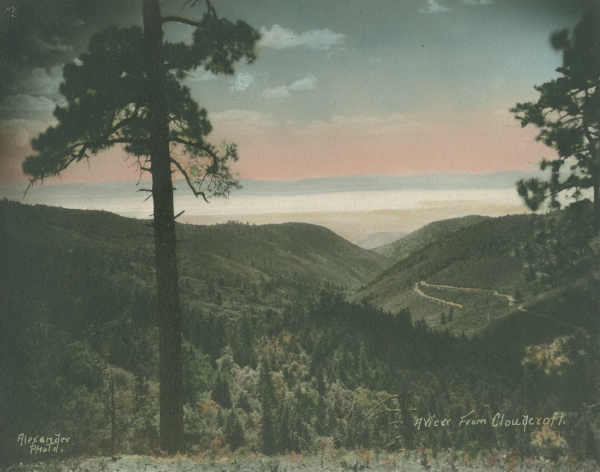Self-Guided Learning
Letter from the editor
 Jim Alexander, A View from Cloudcroft, New Mexico, 1927–1931.
Courtesy of the Palace of the Governors Photo Archives (NMHM/DCA),
Neg. No. HP.2012.20.21.
Jim Alexander, A View from Cloudcroft, New Mexico, 1927–1931.
Courtesy of the Palace of the Governors Photo Archives (NMHM/DCA),
Neg. No. HP.2012.20.21.
By Charlotte Jusinski
One bright day back in December, I was sitting at a wobbly wooden table at Michael’s Kitchen in Taos with writer Jim O’Donnell. Jim is penning a piece about Taos Pueblo for a future El Palacio, and we were touching base about it when he asked a challenging yet common question.
“How far back in history do you want me to go with this?” he asked. Indeed, he said, the story’s entire word count could be taken up just with the events of the 1940s that contributed to the current-day situation; how should we fit it all in?
This eternal question about historical pieces is never easy to answer. Volumes can and do come out of seemingly simple aspects of New Mexico’s history. Every page in El Pal could be dedicated entirely to a single historical subject and not even scratch the surface. How to reduce that to 3,500 words or so?
I thought for a moment, and tried to consider my answer with regards to our readership and how I suspect folks use El Palacio. Then, the answer—in this particular situation, at least—became clear.
“Just throw the reader a bone,” I said. Drop in a few proper names that our readers can pluck out of the story and Google. Offer a single sentence about a peripheral artist so the reader has the chance to check a volume of their paintings out of the library. If you only have ten words to describe a court case, as long as an El Pal reader has its name, that will likely be enough.
This works because the El Palacio reader is voracious. If we spark someone’s curiosity in an Army general or an Indigenous leader or a town in the southern part of the state, they won’t just close the magazine and say, “Well, I wish I knew more about that.” They’ll take the initiative and look it up. They’ll go out of their way to learn. They’ll write us and say, “You mentioned such-and-so in a story two issues ago, and I haven’t been able to get it out of my head; do you have more resources about it?”
I love this about El Pal readers, because they read the way I do. They aren’t content with only what’s within our pages. Their lives are lives of inquiry, and as long as we can offer a hint at another door into a whole new world of learning, that is sometimes all the background we need (or can fit).
This issue is ripe for the forever-student. Many of these stories cover massive subjects that practically burst out of the binding. Plasma dating artifacts is mercifully (a bit) simplified in the hands of Jason Shapiro; Thomas Williamson interrogates the mammalian history of New Mexico; Alexander La Pierre whets your appetite with the origins of Southwestern cuisine; Santa Fe Poet Laureate Elizabeth Jacobson offers teasers from renowned local poets that will make you want to buy a book or two; British Museum curator Hugo Chapman elucidates how an object as simple as a piece of paper is a chapter in the history of communication. Maybe you’ll be inspired to travel to London to leaf through print archives as Chapman has invited us to do, or perhaps to Spain to see a Moros y Cristianos pageant, take a jaunt to Peru to see how the past and present comingle, get in the car and traverse the Santa Fe Trail as the Kingsbury family did—or keep it close to home and dig down into the ground to discover Santa Fe’s past. All of the pieces in these pages are complete, but all of them also contain the ends of threads into various avenues of research and intrigue.
Grab a thread and hold on. Follow it, if your interest is piqued. Tie a knot to your finger so you don’t forget.
But whatever you do, never stop learning.
—
